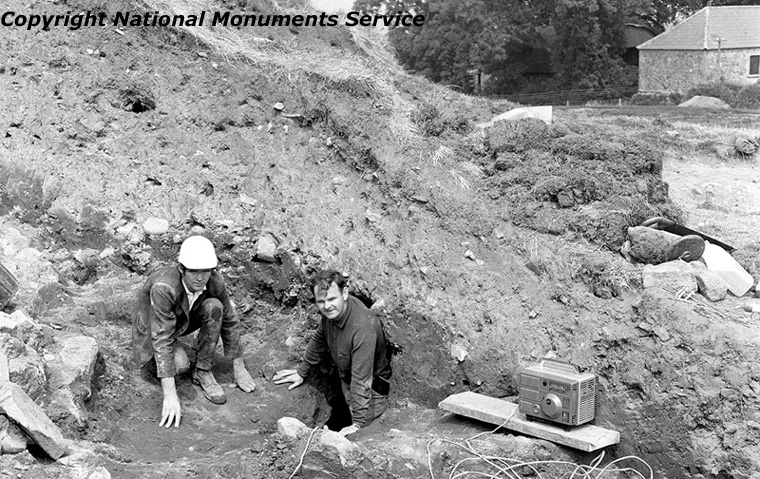Knowth, A Mecca for Prehistoric Pilgrims
Printed in The Irish Times | 12 November 1986
John Rock and George Eogan at the opening to the passage of the Eastern tomb at Knowth in August 1969
In a second extract from his book about the excavation of the passage-tombs at Knowth, Co Meath, George Eogan, professor of archaeology at University College, Dublin, speculates about the prehistoric religious rites that may have been held there.
The orientation of passage-tombs vary and may have depended partly on the existence of significant points of alignment. Other events may have been a factor as well. For example, from tomb orientation at Newgrange, one might theorise that events such as burials occurred at sunrise on December 21st, the mid winter solstice. This would have been an important time of the year for members of a farming community, as they could begin to expect longer and warmer days.
At Knowth, however, the orientation of the great mound suggests that there could have been two ceremonies at different times, the vernal equinox on March 20th or 21st , and the autumnal equinox on September 22nd or 23rd. at these times, the sun rises and sets directly in the east and west, while day and night have equal lengths. The spring equinox represents the beginning of the growing season, and the harvest would have been gathered at the autumnal equinox.
At Knowth one might visualize a morning ceremony on the east side, and an evening ceremony on the west side. Such rites could have been the occasion of a pan-passage-tomb festival involving people from far and wide, providing a link between life and liturgy. Part of the event might have involved an enactment of ritual outside the tomb, for instance a procession around the mound, taking advantage of the decoration on the kerbstones - each one perhaps representing a "station" within a system.
Especially at Knowth, an added emphasis was given to the tomb entrance areas. These must have been significant (as were the courts of court-tombs), because the site had to be designed in order to allow the kerb to curve inwards, which was a further complication in its construction. Most of the kerbstones decorated in the lavish style occur around the entrances to both tombs. This style can be considered as symbolism for all participants, lay as well as religious, and therefore the most public of all the styles. The incurving of the kerb created a reserved area outside the two entrances.
Due to their size, the reserved areas could have contained only a small number of people, presumably priests who performed the ceremonies for the congregation gathered behind. We do not know the nature of the ceremonies, but the various features such as stone settings must have served a related purpose. For example, on the east side, one might imagine the principal celebrant standing on the small limestone flag, which is central to the reserved area. If the celebrant looked westwards, he would have been in line with the standing stone and the central line on the kerbstone before the entrance.
The trappings used in the ceremonies are not yet clearly established. It may be assumed that part of the ritual involved exotic items, notable amongst which would have been the conical stone objects averaging 25 cm long from Knowth and Newgrange. Both were found near the entrances to the tomb, that at Newgrange lying within the quartz-paved stone setting which is rather similar to some of the Knowth settings, while the Knowth object was in a small scoop in the old ground surface on the northern side of the entrances to the western tomb. The Newgrange piece is plain but its surface is polished. The Knowth object is highly decorated. Most of the body has a series of arched grooves which terminate at a channel which runs down from the top to the bottom. In an area just below the unexpanded head there are three arcs.
It is of interest that both the Knowth and Newgrange stone objects are phallus-shaped, and the rites could in part have concerned fertility, emphasising the continuity of society. The Knowth maceheads might also have served in such ceremonies, while the more splendid piece could originally have had a wider function, perhaps belonging to the most important person in the community a political or religious leader and therefore being the common possession of the community as a whole. Its last visible role may have been played at the dedication ceremony of the great site, after which it was withdrawn forever from human sight, becoming the object deposited in the tomb. Such an event could have been more than simply an enshrinement of this communal emblem; it conferred further status upon the ostentatious eastern tomb.
Knowth, and the passage-tombs of Ireland by George Eogan, is published by Thames and Hudson.
Boyne Valley Private Day Tour
 Immerse yourself in the rich heritage and culture of the Boyne Valley with our full-day private tours.
Visit Newgrange World Heritage site, explore the Hill of Slane, where Saint Patrick famously lit the Paschal fire.
Discover the Hill of Tara, the ancient seat of power for the High Kings of Ireland.
Book Now
Immerse yourself in the rich heritage and culture of the Boyne Valley with our full-day private tours.
Visit Newgrange World Heritage site, explore the Hill of Slane, where Saint Patrick famously lit the Paschal fire.
Discover the Hill of Tara, the ancient seat of power for the High Kings of Ireland.
Book Now
Home
| Visitor Centre
| Tours
| Winter Solstice
| Solstice Lottery
| Images
| Local Area
| News
| Knowth
| Dowth
| Articles
| Art
| Books
| Directions
| Accommodation
| Contact

